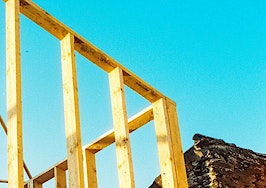At Inman Connect Las Vegas, July 30-Aug. 1, 2024, the noise and misinformation will be banished, all your big questions will be answered, and new business opportunities will be revealed. Join us.
Despite month-over-month gains, homebuilding activity is still lagging behind 2023, according to the U.S. Census Bureau and the U.S. Department of Housing and Urban Development’s latest New Residential Construction report.
Building permits increased 3.4 percent month over month to a seasonally adjusted annual rate of 1,446,000; however, permit activity was down 3.1 percent from June 2023’s seasonally adjusted annual rate of 1,493,000. Building permits for single-family homes fell from May to June, sliding 2.3 percent to 934,000.
Housing starts followed a similar trend in May, with monthly gains and annual declines. The seasonally adjusted annual rate for privately owned housing starts reached 1,353,000 in June—3.0 percent above May and 4.4 percent below June 2023. Like single-family building permits, single-family housing starts were stifled in June, declining 2.2 percent to a seasonally adjusted annual rate of 1,002,000.
Although permitting and starts were down annually, housing completions in June were well above 2023 levels.
Privately-owned housing completions increased 10.1 percent month over month and 15.5 percent year-over-year to a seasonally adjusted annual rate of 1,710,000. Single-family completions got a small boost, rising 1.8 percent month-over-month to a seasonally adjusted annual rate of 1,019,000.
Bright MLS Chief Economist Dr. Lisa Sturtevant said the decline in apartment construction “was not surprising,” given the breakneck speed builders maintained in 2023 to meet heightened renter demand.
“In 2023, there were record numbers of apartments delivered in some markets across the U.S., leading developers to pull back on bringing new units to the market,” she said in a statement. “Last year, rents in some markets fell and property managers were offering rent and other concessions to attract renters.”
“In June 2024, the number of new starts of units in buildings with five or more units (360,000) was down 23.4 percent compared to a year ago,” she added.
As far as single-family housing starts, Sturtevant and Realtor.com Senior Economist Joel Berner said the slowdown in permits and starts reflects slowing homebuyer activity and weakening homebuilder sentiments amid several market headwinds.
“Demand for single-family housing is still strong; however, higher mortgage rates and record high home prices have caused some prospective buyers to pause their home search,” Sturtevant said. “… Builders continue to offer rate buy downs and upgrades to buyers, but traffic has dropped as affordability has become a growing concern and the inventory of existing homes has expanded.”
Berner said the latest inflation report offers hope of an impending rate cut, which may motivate homebuyers to snap up lingering new-home inventory.
“Homebuilder sentiment has slid for a third consecutive month as construction firms fear being left with unsold new inventory on their hands, and homebuyers are putting off their purchases until their financing options improve,” he said. “However, the latest inflation reports may precipitate rate cuts that spur on new home buyer activity to match this month’s positive construction news.”
Although June’s report revealed lackluster annual trends, Berner and First America Deputy Chief Economist Odeta Kushi said monthly gains in permitting, starts and completions are a silver lining the industry shouldn’t ignore.
“Home prices remain near an all-time high, but strong year-over-year inventory growth of for-sale listings and a slow pace of new home sales pose a threat to homebuilders looking to cash in on their new building projects,” Berner said in a statement. “In spite of these headwinds, residential construction in June is showing signs of improvement.”
Kushi added, “Despite the challenging environment, the housing market remains structurally underbuilt. For more than a decade, homebuilding has not kept up with the demand for shelter, creating a housing supply deficit that has proven difficult to reduce significantly. As builders break ground on additional housing, we will inch closer to balancing our housing deficit.”













